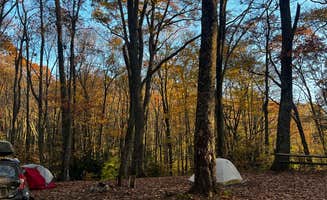Dispersed camping near Appalachia, Virginia offers remote outdoor experiences in the surrounding Jefferson National Forest and wildlife management areas. The region sits in the Appalachian Mountains with elevations ranging from 1,700 to 3,500 feet and features steep terrain with mixed hardwood forests. Seasonal considerations affect accessibility, with spring bringing significant rainfall and potential road washouts on unpaved access routes.
What to do
Fishing opportunities: Hidden Valley WMA provides access to a calm, clean lake suitable for fishing. "Easy to access in a vehicle several campers campsites available. Lake is calm and clean for water recreation," notes Kathleen B. about the water activities available.
Wildlife observation: The surrounding forests support diverse wildlife including deer, turkey, and various bird species. Hunters should verify seasons and obtain appropriate permits through Virginia Department of Wildlife Resources before planning a trip.
Hiking nearby: While primitive camping options near Appalachia are limited to a few wildlife management areas, several trailheads provide day hiking opportunities within a 30-minute drive. The region connects to sections of the Appalachian Trail and Jefferson National Forest trail systems.
What campers like
Solitude and privacy: Many visitors appreciate the secluded nature of Hidden Valley WMA. "We had the place to ourselves which was really great," reports Rhys R., highlighting the lack of crowds even during typical camping seasons.
Natural setting: The forest environment features abundant ferns and natural beauty. One camper describes the area as a "pretty quiet cool fern filled Forrest and lake," adding character to the primitive camping experience.
Established facilities: Despite being dispersed camping, some basic amenities exist. According to Betsy W., "Porta Jon available at campground and boat dock. Plenty of dead wood for fires. Trash cans available. Rocks for fire pits and no tables."
What you should know
Access challenges: The road conditions present difficulties for some vehicles. "The road up is a pretty harsh grade for 4 miles. Our short bus Skoolie had some troubles with it," warns Zoey T., indicating potential access issues for larger vehicles or those with limited clearance.
Permit requirements: Virginia wildlife management areas require permits. Camping is "free, technically. (you need to purchase an Access pass from Virginia Wildlife for 4 dollars online, and add a camping authorisation to your account)," explains Rhys R., clarifying the permit process for potential visitors.
Limited availability: The region has fewer dispersed camping options compared to other parts of Virginia. Options like Paul Van Booven Wildlife Management Area and Asher Hunting Access Area exist but with fewer established primitive sites and facilities.
Tips for camping with families
Safety considerations: Bear activity occurs throughout the region, requiring proper food storage. Hidden Valley WMA provides bear-resistant containers at designated camping areas to reduce wildlife encounters.
Water safety: Families camping with children should note that while the lake provides recreation opportunities, no lifeguards or designated swimming areas exist. Parents must supervise children near water at all times.
Weather preparedness: Paul Van Booven Wildlife Management Area and other primitive sites in the region experience rapid weather changes due to mountain terrain. Pack additional layers and rain gear regardless of forecast, as afternoon thunderstorms develop quickly during summer months.
Tips from RVers
Size restrictions: Large RVs face significant challenges on access roads. Smaller campers and vans under 25 feet have better success navigating the steep grades and tight turns.
Limited hookups: No electrical, water or sewer connections exist at any primitive sites near Appalachia. RVers must be fully self-contained with sufficient water, propane, and waste storage capacity for their entire stay.
Leveling challenges: Asher Hunting Access Area and similar locations feature uneven terrain. Bring multiple leveling blocks and stabilizers as most pull-off camping spots require significant adjustment to achieve level positioning.


